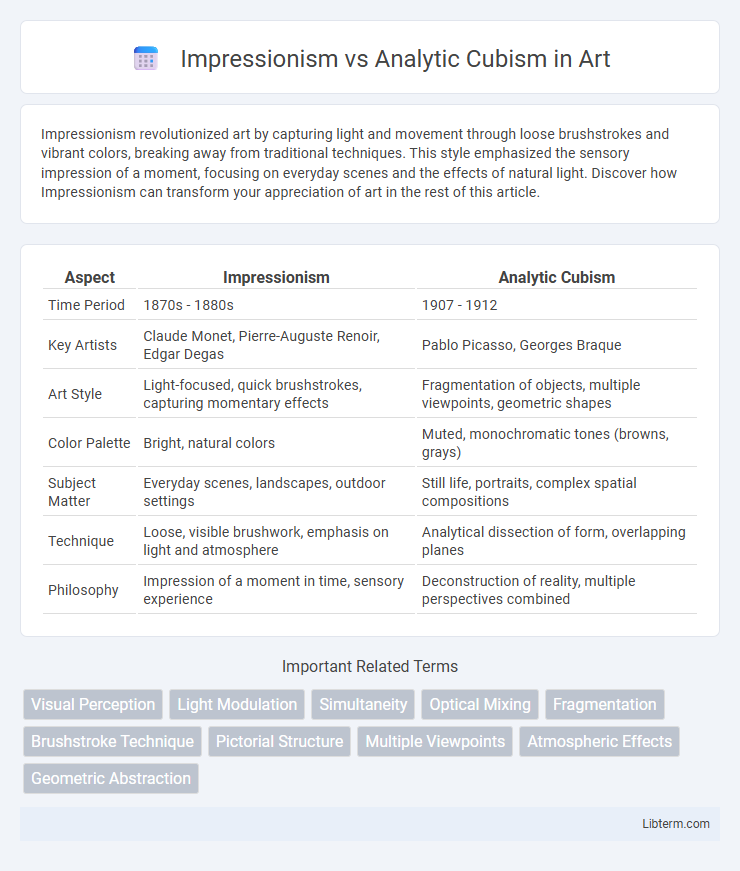Impressionism revolutionized art by capturing light and movement through loose brushstrokes and vibrant colors, breaking away from traditional techniques. This style emphasized the sensory impression of a moment, focusing on everyday scenes and the effects of natural light. Discover how Impressionism can transform your appreciation of art in the rest of this article.
Table of Comparison
| Aspect | Impressionism | Analytic Cubism |
|---|---|---|
| Time Period | 1870s - 1880s | 1907 - 1912 |
| Key Artists | Claude Monet, Pierre-Auguste Renoir, Edgar Degas | Pablo Picasso, Georges Braque |
| Art Style | Light-focused, quick brushstrokes, capturing momentary effects | Fragmentation of objects, multiple viewpoints, geometric shapes |
| Color Palette | Bright, natural colors | Muted, monochromatic tones (browns, grays) |
| Subject Matter | Everyday scenes, landscapes, outdoor settings | Still life, portraits, complex spatial compositions |
| Technique | Loose, visible brushwork, emphasis on light and atmosphere | Analytical dissection of form, overlapping planes |
| Philosophy | Impression of a moment in time, sensory experience | Deconstruction of reality, multiple perspectives combined |
Introduction to Impressionism and Analytic Cubism
Impressionism emerged in the late 19th century, emphasizing light, color, and everyday scenes with loose brushwork to capture fleeting moments. Analytic Cubism, developed by Picasso and Braque in the early 20th century, deconstructed objects into geometric shapes and multiple perspectives to analyze form and structure. While Impressionism prioritizes naturalistic depictions of light and atmosphere, Analytic Cubism focuses on abstracting reality through fragmented, overlapping planes.
Historical Context and Origins
Impressionism emerged in the late 19th century France as a reaction against traditional academic painting, emphasizing light, color, and everyday scenes with artists like Claude Monet leading the movement. Analytic Cubism developed in the early 20th century, pioneered by Pablo Picasso and Georges Braque, during a period of rapid industrialization and scientific discovery, focusing on deconstructing objects into geometric shapes to depict multiple viewpoints simultaneously. Both movements reflect significant shifts in artistic approaches tied to their respective historical contexts, with Impressionism capturing modern life's transient effects and Cubism challenging conventional perspectives through abstraction.
Key Artists and Influencers
Claude Monet and Pierre-Auguste Renoir are prominent Impressionist artists known for their emphasis on light, color, and natural landscapes. Pablo Picasso and Georges Braque pioneered Analytic Cubism, characterized by fragmented forms and multiple viewpoints. Impressionism reflects fleeting moments with loose brushwork, while Analytic Cubism deconstructs objects into geometric shapes to challenge perception.
Core Philosophies and Artistic Goals
Impressionism emphasizes capturing the fleeting effects of light and color to convey immediate sensory experiences, prioritizing naturalistic observation and spontaneity. Analytic Cubism deconstructs subjects into geometric shapes and multiple viewpoints to explore the underlying structure and challenge traditional perspective. The core philosophy of Impressionism celebrates perception and momentary impressions, while Analytic Cubism focuses on intellectual analysis and fragmented reality.
Techniques and Brushwork Styles
Impressionism employs loose, rapid brushstrokes to capture light and natural scenes with vibrant color and visible texture, emphasizing spontaneity and atmosphere. Analytic Cubism uses fragmented, geometric brushwork to deconstruct objects into facets and planes, presenting multiple perspectives within a subdued color palette. The techniques of Impressionism prioritize fluidity and luminosity, whereas Analytic Cubism emphasizes structure and abstraction through meticulous, interlocking shapes.
Color Palette and Use of Light
Impressionism features a vibrant color palette with bright, natural hues that capture the effects of sunlight and atmospheric conditions, emphasizing light's transient qualities. Analytic Cubism employs a muted, monochromatic palette dominated by browns, grays, and ochres to deconstruct objects and focus on form, minimizing the role of traditional light and shadow. Impressionists use light to create depth and movement, while Analytic Cubism breaks down light into fragmented geometric planes, emphasizing spatial complexity over natural illumination.
Representation of Space and Form
Impressionism captures space and form through light and color, emphasizing natural scenes with loose, fleeting brushstrokes that evoke atmosphere and movement. Analytic Cubism deconstructs objects into geometric shapes, presenting multiple viewpoints simultaneously to challenge traditional perspective and flatten spatial depth. This approach fragments form and space, creating a complex, abstracted interplay between planes and volumes.
Iconic Works and Their Significance
Impressionism, exemplified by Claude Monet's "Impression, Sunrise" and Pierre-Auguste Renoir's "Dance at Le Moulin de la Galette," emphasizes light, color, and everyday scenes, revolutionizing visual perception with fleeting moments captured through loose brushstrokes. Analytic Cubism, pioneered by Pablo Picasso's "Les Demoiselles d'Avignon" and Georges Braque's "Violin and Candlestick," deconstructs objects into geometric forms and multiple viewpoints, fundamentally challenging traditional representation and perspective. These iconic works underscore crucial shifts in art history: Impressionism's quest for sensory experience versus Analytic Cubism's intellectual exploration of form and structure.
Impact on Modern Art Movements
Impressionism revolutionized modern art by emphasizing light, color, and everyday scenes, inspiring movements like Fauvism and Abstract Expressionism with its focus on perception and spontaneity. Analytic Cubism, developed by Picasso and Braque, introduced fragmented forms and multiple perspectives, laying the groundwork for Surrealism, Futurism, and Constructivism through its abstract representation of reality. Both movements challenged traditional artistic conventions, fundamentally reshaping the trajectory of 20th-century art.
Lasting Legacy and Contemporary Relevance
Impressionism revolutionized visual perception by capturing fleeting light and atmosphere, influencing modern art's emphasis on spontaneity and sensory experience. Analytic Cubism deconstructed form and space into geometric planes, laying the groundwork for abstract and conceptual art movements. Both continue to shape contemporary artistic practices, with Impressionism inspiring expressive brushwork and color use, while Cubism informs structural experimentation and multiple perspectives.
Impressionism Infographic

 libterm.com
libterm.com